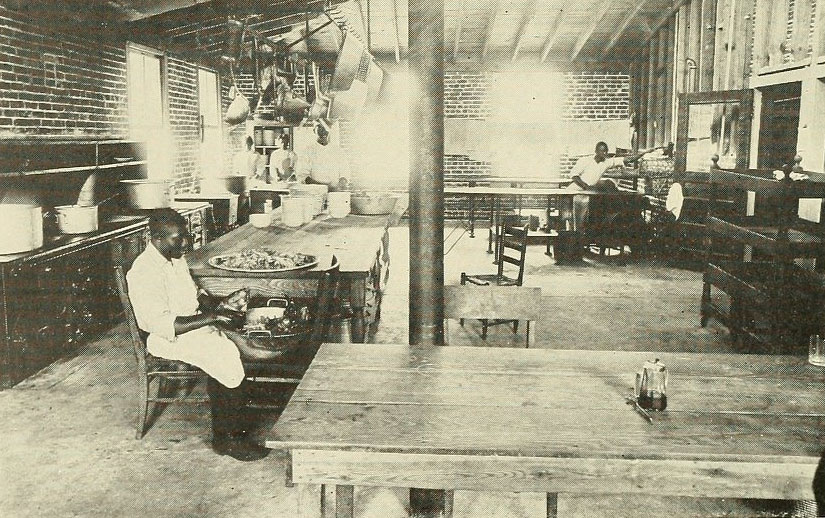The April 1, 1915 fire that gutted the campus dining hall required that the roof of the cafeteria and much of the adjoining kitchen be rebuilt. Pictures of the repaired facilities figured prominently in the Training School Quarterly as proof that ECTTS would not be stopped by adversity. As pictured, the repaired cafeteria looked excellent. However, the kitchen pictured below it, only workable, yet staffed with African-American cooks preparing a meal. The upper right section of the kitchen photo captures the new wooden rafters and sub-roofing along with new wooden framing adjoining the passage way to the cafeteria. Establishing that all was well with the dining facility was the primary intent of these prominently displayed images.
However, the most important legacy of the kitchen picture is the human dimension it captures: the picture stands as the first depiction of African-Americans at ECTTS. The central figure is seated, handling food preparation, while four other cooks appear in the background, apparently aware, modestly and from a distance, that their picture was being taken. All except the foreground figure are facing the camera. The kitchen staff appears entirely African-American, though presumably a white supervisor was somewhere, managing things. Indeed, early on that person was the household economics instructor, Jennie Ogden. Later, a “matron” was hired to manage the kitchen staff. The first was Mary Rankin, followed by Nannie F. Jeter, both trained dietitians. Unlike those doing the work of the kitchen, the supervisors, not pictured in the kitchen shot, were white.
The limits of Jim Crow segregation, if not white supremacy, thus appear in these photos. White supremacy was maintained insofar as the cafeteria, pictured above, was where privileged white students ate. But segregation was clearly breached in the kitchen wherein African-Americans prepared and served with their own hands food consumed by the students. Although separately, the staff surely ate the food as well. At some level, the white matrons must have worked closely with the African-American staff in orchestrating campus meals. Segregation was porous, then, through the kitchen and in the cafeteria.
Paradoxically, even as ECTTS taught domestic science and as of 1914, could boast of its new “domestic science laboratory” wherein white students learned to prepare nutritious food for the health and well-being of their families, the same students ate food prepared by African-American cooks in a kitchen facility that by comparison with the domestic science lab, located on the second floor of the Administration Building and “modern in every respect,” seemed less so. In the kitchen, African-Americans served in ways consistent with Booker T. Washington’s practical vision of responsible, vocational labor. But in the domestic science lab, a new philosophy, described by advocate Ellen H. Richards as “euthenics,” taught white women scientific principles empowering them to improve white health through sanitary standards. ECTTS’s move from the Little Red Cabin to the domestic science lab seemingly enhanced white supremacy in the kitchen where scientifically educated students were taught to prepare food and teach others how to do the same. Under the guise of education and best practices in the kitchen, ECTTS thus contributed to domestically-oriented expressions of white supremacy.
Sources
- Armstrong, Martha. “Household Arts in Rural Schools.” Training School Quarterly. Vol. 1, no. 2. July, August, September, 1914. Pp. 92-94.
- Cooley, Angela Jill. To Live and Dine in Dixie: The Evolution of Urban Food Culture in the Jim Crow South. Athens: University of Georgia, 2015.
- “Dining Hall, E.C.T.T. School, Greenville, N.C.” J. Y. Joyner Library, Identifier: 275.1.d.14. East Carolina University. Greenville, N. C. https://digital.lib.ecu.edu/317.
- “Dining Hall reconstruction after fire.” J. Y. Joyner Library, Identifier: 55.01.0139. East Carolina University. Greenville, N. C. https://digital.lib.ecu.edu/22871.
- “Dining Hall reconstruction after fire.” J. Y. Joyner Library, Identifier: 55.01.0541. East Carolina University. Greenville, N. C. https://digital.lib.ecu.edu/22941.
- Hale, Elizabeth. Making Whiteness: The Culture of Segregation in the South, 1890-1940. Vintage, 1999.
- “Men working in kitchen.” University Archives # 50-02-1915 ¾. J. Y. Joyner Library. East Carolina University. Greenville, N.C. https://digital.lib.ecu.edu/10323.
- “The new domestic science laboratory.” University Archives # 50.03.1.13. J. Y. Joyner Library. East Carolina University. Greenville, N.C. https://digital.lib.ecu.edu/11486.
- “The Remodeled Dining Hall and Kitchen, East Carolina Teachers’ Training School.” Training School Quarterly. Vol. 2, no. 3. October, November, December, 1915. Frontispiece.
Citation Information
Title: Dining Hall Staff
Author: John A. Tucker, PhD
Date of Publication: 6/7/2018
